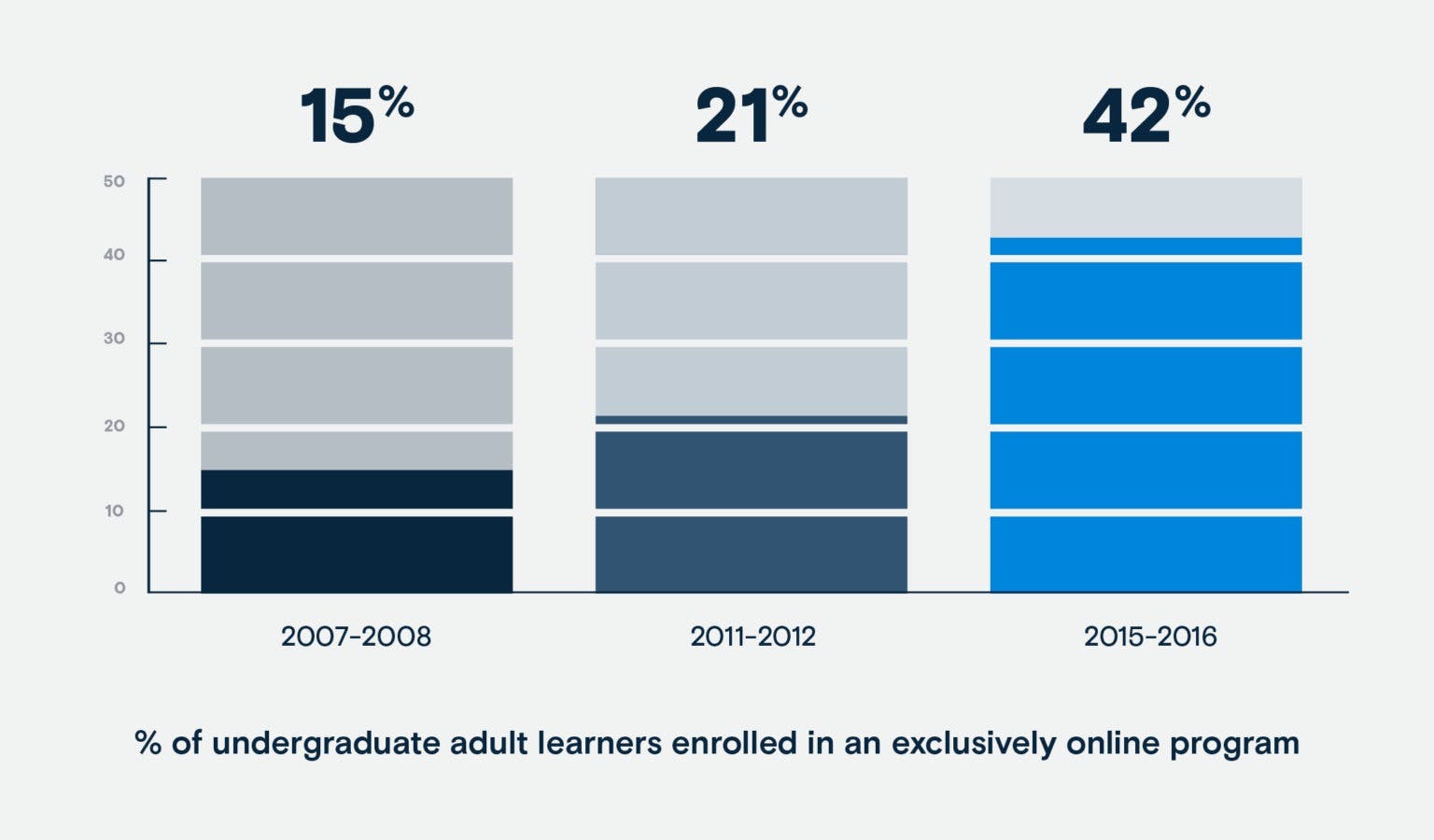Article
July 12th, 2021 · 4 min read
Online learning statistics L&D leaders need to know in 2024

This blog is part of our series on workforce education statistics that you need to know to develop and execute learning programs that build a resilient, thriving workforce, prepared for the challenges of today and tomorrow.
Online learning has become the new norm and continues to expand its reach. The total market for online learning worldwide is forecast to expand exponentially, reaching over $370 billion by 2026. And one of the biggest growth drivers in the industry is the business sector.
This rise of online learning has been driven by both adult learners and companies, for the benefit of both. The positive impact of online learning includes improved access to quality higher education, greater opportunities for in-demand skills development among employees, plus advancements on the diversity, equity and inclusion (DEI) front.
For companies, it’s worth investing in online learning and training for employees as it also leads to growth opportunities for both the business and the individual. For example, a recent survey reveals that businesses with comprehensive training programs have 218 percent higher revenue per employee and 24 percent higher margins.
Here are more online learning statistics, trends and data related to the evolving landscape of higher education and workplace learning.
Top online learning statistics
- With about 90% of corporations now using online learning compared to just 4% in 1995, the business sector is bound to be one of the biggest growth drivers in the online learning industry this decade. (LinkedIn & KPMG)
- Estimated at $144 billion in 2019, the global e-learning market is expected to reach $374.3 billion by 2026. (Facts & Factors)
- 2,500 colleges offer online programs, but the 100 largest players have nearly 50% of student enrollment. (U.S. Department of Education)
- Nearly nine in 10 chief online learning officers said online learning is a greater priority for their schools than before the pandemic. (CHLOE 6)
- While overall post-secondary enrollment has declined slightly, online enrollment increased by 4% per year since 2013, primarily driven by increasing adult learner update, with growth expected to continue moving forward. (InStride)

Online learning in the workplace
- A majority of HR leaders (64%) believe that in the future, the need for continuous lifelong learning will demand higher levels of education and more credentials – and 52% believe that most advanced degrees will be completed online. (Northeastern University)
- Online credentials are now mainstream, with a solid majority (61%) of HR leaders believing that credentials earned online are of generally equal quality to those completed in-person. (Northeastern University)
- 75% of employers reported that they already rely on online training tools and courses to perform their own jobs. (Future Learn)
- Employees who continued educating themselves online were more likely to receive promotions (23.0%), pay raises (19.8%) and leadership roles (17.5%). (Future Learn)
- The most commonly valued traits that hiring managers noticed among employees who had invested in their career through online learning are: the ability to work independently (51.4%), ability to use technology and online platforms (18.3%) and ability to stay on task (11.2%). (Future Learn)
- The top reasons college and university providers and faculty members consider when offering a new online program include employment demand for specific skills and demand from students. (Statista)
Adult learners and online engagement
- About half of online college students are millennials (ages 28-38), about one-third are from Generation X (ages 39-54), and the remainder is split between baby boomers (ages 55-73) and Gen Zers (ages 18-22). (The Learning House and Education Dynamics)
- Many factors impact re-enrolling adults' decision for additional education including: courses and training that fit their schedule (61%), guaranteed employer outcome (ex: wage increase) (59%) and quality online and distance learning opportunities (44%). (Lumina, Gallup, Strada)
- Eight out of 10 adult learners are interested in pursuing online learning. (LinkedIn)
- Adult learners over the age of 35 were more than five times as likely as learners under age 26 to say that online or virtual classes had always been their preference. (EAB)
- In fall 2020, U.S. enrollment was predicted to consist of 7.5 million students aged 25 or older. (NCES)
- The majority of adults are interested in going back to school and more than three quarters (76%) judge the quality of online learning to be “excellent” or “very good.” (Champlain College)
Online learning and talent acquisition
- Three-quarters of hiring managers were more likely to hire applicants with solely online learning today than they were prior to 2020. (FutureLearn)
- Convenience was a strong motivator for online students overall. Almost one-quarter (23%) of participants cited a need to schedule studying around existing commitments, such as work or family obligations. (Best Colleges)
- Almost half (48%) of online and remote students were motivated by career and employment goals to enroll in their programs. (Best Colleges)
The online learning movement was set in motion a while back, but these recent online learning statistics reflect how the momentum continues to accelerate and transform the workforce education landscape.
Want to unlock more learning and education statistics like these? Download the report, 5 new insights leaders are using to inform workforce education.

You can address talent development challenges
See how a partnership with InStride can meet the challenges of tomorrow, with action today.





